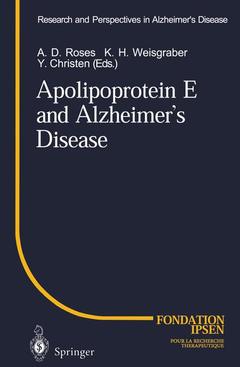Description
Apolipoprotein E and Alzheimer's Disease, Softcover reprint of the original 1st ed. 1996
Research and Perspectives in Alzheimer's Disease Series
Language: English
Subject for Apolipoprotein E and Alzheimer's Disease:
Publication date: 12-2011
188 p. · 15.5x23.5 cm · Paperback
188 p. · 15.5x23.5 cm · Paperback
Description
/li>Contents
/li>
There is now considerable genetic evidence that the type 4 allele of the apolipoprotein E gene is a major susceptibility factor associated with late-onset Alzheimer's disease, the common form of the disease defined as starting after sixty years of age. The role of apolipoprotein E in normal brain metabolism and in the pathogenesis of Alzheimer's disease are new and exciting avenues of research. This book, written by the most outstanding scientists in this new field, is the first presentation of results concerning the implications of apolipoprotein E on the genetics, cell biology, neuropathology, biochemistry, and therapeutic management of Alzheimer's disease.
Apolipoprotein E and Alzheimer’s Disease: State of the Field After Two Years.- Role of Apolipoprotein E in Alzheimer’s Disease: Clues from its Structure.- Apolipoprotein E4, Cholinergic Integrity, Synaptic Plasticity and Alzheimer’s Disease.- Pattern of Apolipoprotein E Immunoreactivity During Brain Aging.- Apolipoprotein E: Structure, Function, and Possible Roles in Modulating Neurite Extension and Cytoskeletal Activity.- Apolipoprotein E Role in Maintaining the Integrity of the Aging Central Nervous System.- Very Low Density Lipoprotein Receptor and Alzheimer’s Disease.- Apolipoprotein E and Apolipoprotein E Receptors in the Central Nervous System: Relationship with Alzheimer’s Disease.- Tau Protein and the Neurofibrillary Pathology of Alzheimer’s Disease.- Tau Protein and Alzheimer Paired Helical Filament Assembly: Interacting Domains and Control Residues.- The ßA4 Amyloid Peptide Enhances Cellular Uptake of Apolipoprotein E-Containing Lipoproteins by the Low-Density Lipoprotein Receptor-Related Protein/?2-Macroglobulin Receptor.- Interactions of Apolipoprotein E with Microtubule-Associated Proteins.- Chaperoning Amyloid in Alzheimer’s Disease: The Art of Avoiding Sticky Situations?.- Apolipoprotein E Oxidation and Functional Consequences.- Ethnic Variation in the Association Between APOE-?4 and Alzheimer’s Disease: A Follow-up Study.- The Search for Additional Alzheimer’s Disease Genes.
© 2024 LAVOISIER S.A.S.
These books may interest you

Molecular Mechanisms of Dementia 116.04 €



